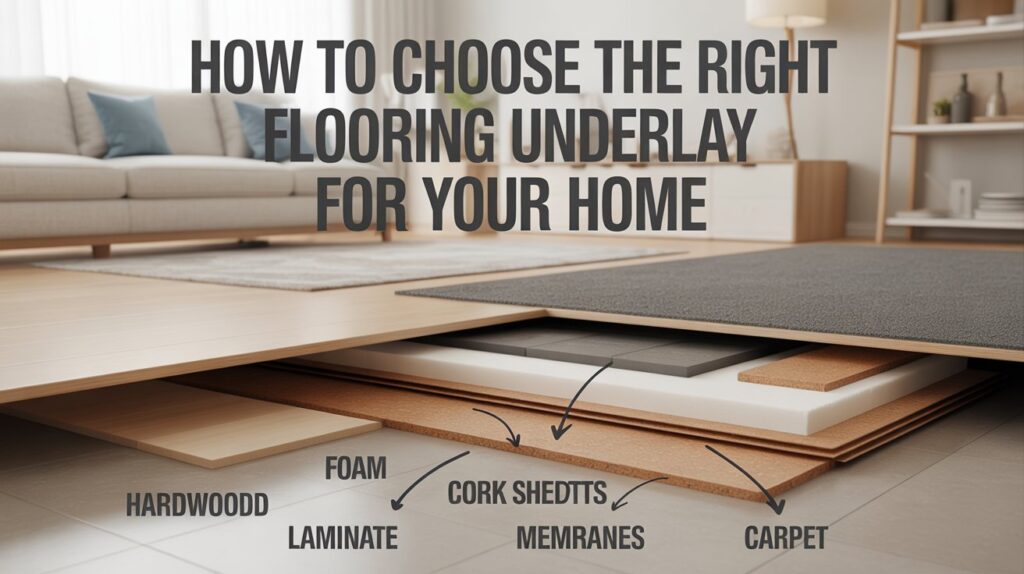Have you ever stepped into a room that just feels right, warm, quiet, and comfortable, without knowing exactly why? The secret often lies beneath your feet. While most people focus on flooring style or color, few realize that what is underneath can make an even bigger difference.
The underlay may be hidden, but it shapes how your home feels, sounds, and stays cozy through the seasons. It supports the surface above, reduces noise, and improves insulation. Without the right base, even the most beautiful floors can lose their appeal over time.
This guide explains how to choose the best option for your space based on material type, room use, and comfort level, so every step at home feels better for years.
1. What Is Flooring Underlay and Why Does It Matter
Before choosing materials or finishes, it helps to know what sits underneath. Underlay is the thin layer placed between the subfloor and the visible flooring. It provides cushioning, absorbs sound, and offers insulation. Think of it as a foundation that supports every step.
A good base protects floors from damage and helps prevent squeaks or uneven areas. For example, a soft layer can make laminate flooring feel smoother, while a denser one can keep tiles firm and stable. The right type can also keep warmth in and reduce energy use. Though it is hidden, this part of the installation quietly adds comfort and quality to your home.
2. Match Underlay Type to Your Flooring
Every floor surface has different needs. Using the wrong base can affect comfort, noise, or durability. Here are a few common types:
- Foam underlay: lightweight, easy to install, great for laminate or vinyl.
- Rubber underlay: firm, durable, perfect for high-traffic areas.
- Felt underlay: soft and warm, ideal for carpeted spaces.
When installing new floors, the right flooring underlay makes a big difference in how a project looks and performs over time. A strong, dependable base helps every type of surface material perform at its best, ensuring a smoother installation and longer-lasting results. That’s why many contractors and fitters turn to trusted suppliers like Magnet Trade, who offer durable, well-tested underlay options suited to different flooring materials and working environments. Their collections help ensure lasting comfort, noise control, and reliable results with every job.
3. Consider Room Function and Lifestyle
Every room in your home serves a different purpose, and the type of underlay should match that use. Bedrooms need warmth and softness for comfort, while kitchens and bathrooms require moisture-resistant options. Living rooms and hallways benefit from noise reduction and durable materials.
Here are a few questions to guide your choice:
- Is this a quiet space or a high-traffic area?
- Does the room need extra insulation?
- Will the floor be affected by moisture or temperature changes?
For example, a child’s playroom may need cushioning for safety, while a busy hallway might require something more substantial. Considering your lifestyle ensures that each area feels comfortable and functions smoothly for years to come.
4. Look at Thickness and Material Quality
It can be tempting to think thicker is always better, but that is not true for every type of flooring. A thicker underlay may make carpeted rooms feel softer, but for laminate or hardwood, too much padding can cause movement or damage over time.
Instead, aim for a balanced approach. A mid-thickness layer provides stability without losing comfort. Quality materials also matter. Higher-grade options resist compression and offer better insulation.
Even if they cost slightly more upfront, they tend to last longer and improve overall performance. As a general rule, check the product details or ask your supplier for recommendations before making a purchase. A little care at this stage can prevent future problems.
5. Think About Installation and Maintenance
Underlay is usually easy to fit, especially for DIY projects. Most come in rolls or sheets and can be laid directly over the subfloor. Here are a few practical tips:
- Always start with a clean, dry surface.
- Trim edges neatly to avoid gaps or overlaps.
- Replace old layers when installing new flooring.
- Use moisture barriers where needed, especially in kitchens or basements.
If you are not confident about installation, professional help ensures even coverage and long-term durability. Once installed, the underlay requires minimal upkeep, consisting mainly of proper cleaning and protection of the surface above it. Taking small steps during setup makes a big difference later on.
Conclusion
Selecting the right base layer is more than just a finishing touch. It shapes how your flooring feels and performs over time. Considering your room’s needs, floor type, and material quality will help you make the best choice. With the right underlay, your home stays comfortable, quiet, and efficient for years to come, giving every step a softer, steadier foundation beneath it.

